Why Italy? Because every pebble has a story to tell!! My fascination with Italy started long ago, back during my school days. The history, mystery, culture, the Kings, the Emperors, the Inventors, the Artists and the Philosophers all motivated me to visit Italy. This great motivation became a reality in 2010 during my tenure in Turkey. My trip started on 8th September 2010 from Sabiha Gokcen airport in Istanbul via Turkish Airlines flight TK1837. I was accompanied by my good friend Saurabh. He was a co-worker whom I had met a few weeks earlier while working in India and went on to become my closest pal during our work assignment in Turkey.
The 2.5 hour long flight landed at Leonardo DaVinci International airport in Rome at 5 am. From the airport we took the Airport transfer bus to Roma Termini Railway station which was a half hour ride. After dumping our luggage at the locker facility in the station we boarded our 6.30 am train to Florence, which was our first date with history in Italy. The train ticket costed around 22 Euros and took us nearly 2 hours to reach Santa Maria Novella, Florence.

The historic city of Florence is the birthplace of Italian Renaissance and the current capital of the Tuscany region. It is on the banks of River Arno and is about 100 square km. Our first stop in this great city was the Piazzale Michelangelo. It is a small square designed by Guiseppe Poggi and built on a hill with a terrace, offering a panoramic view of the city. From the terrace we can see the Ponte Vicchio Bridge, the Duomo, Palazzo Vecchio (Town Hall) and the bridges across River Arno. The square is marked by the majestic bronze statue of David facing the city.